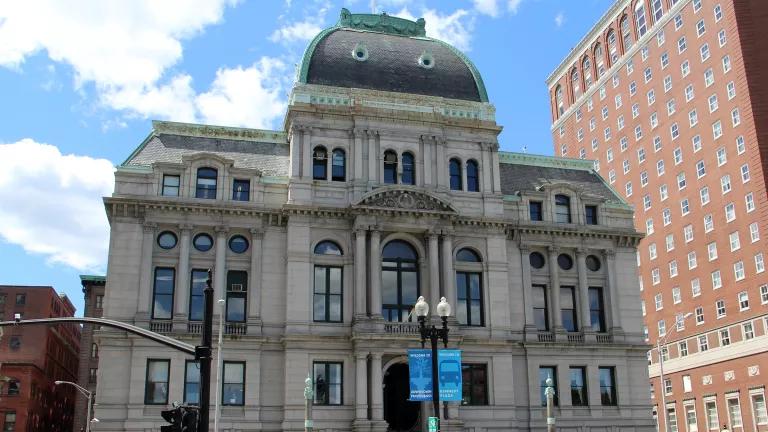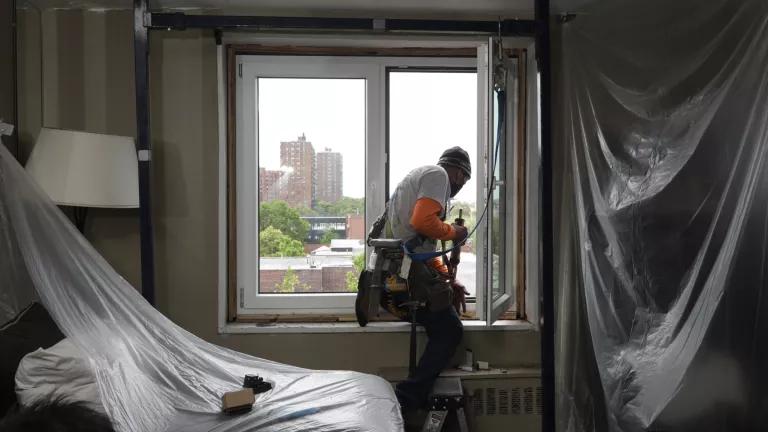Providence Details Energy Efficiency Success—and Recommits
Providence’s third annual municipal energy report shows major savings in city buildings’ energy expenditures. By reducing energy use in municipal buildings, Providence is achieving three aims: reductions of greenhouse gases that contribute to climate change, responsible stewardship of resident health and taxpayer dollars, and leadership by example for other building owners in the area.

Providence City Hall
Providence’s third annual municipal energy report, released on June 4th, shows major savings in city buildings’ energy expenditures. By reducing energy use in municipal buildings, Providence is achieving three aims: reductions of greenhouse gases that contribute to climate change, responsible stewardship of resident health and taxpayer dollars, and leadership by example for other building owners in the area.
The report details several exciting achievements. With contributions from LED conversions and heating system upgrades, greenhouse gas emissions from municipal facilities have decreased 26% over the last seven years, 7% in the last year alone. December 2016 saw the absolute phase-out of heating oil from all City school buildings. Efficiency projects in five municipal buildings are expected to save over $100,000 annually, with total energy reductions down by 14%. The city’s conversion to LED fixtures in streetlights is estimated to save the City $18.9 million in the next ten years. And, energy efficiency upgrades and HVAC control retro-commissioning in City schools led to a 31% increase in average ENERGY STAR scores over the last three years.
These amazing gains in city buildings will soon be matched by the ambition of the private sector. Earlier this spring, Mayor Jorge O. Elorza of Providence announced the launch of RePowerPVD, an ambitious voluntary challenge program that will drive energy efficiency among the city’s large buildings. Over the coming years, this program will challenge the private sector to partner with the city as it seeks to make significant headway in cutting emissions from the building sector.
Challenge participants can choose between two levels of commitment. Building owners and operators can commit to a 20 percent reduction in their energy consumption from a baseline level in 2015 by 2025. In addition, the program will also host a separate, even more ambitious challenge called “Race to Zero,” a competition among building to become the first zero energy building in the city.
RePowerPVD represents a significant step in the city’s trajectory towards ambitious climate goals. In 2015, Providence committed to the Compact of Mayors, and in April 2016, the Mayor Elorza announced a goal to make the city carbon neutral by 2050. A 2014 greenhouse gas inventory found that the building sector produces nearly two-thirds of the city’s total climate pollution, of which the commercial is responsible for almost a third. Fittingly, one of the six priority actions to achieve the Mayor’s goal is to engage building owners in meeting climate targets.
As a result, this program represents an important opportunity to reduce building emissions, and RePowerPVD will be taking steps to ensure that buildings are supported while making these ambitious commitments. The program will provide participants with tools and technical support to make efficiency upgrades and to keep track of their progress. In particular, the program will provide free online reporting through ENERGY STAR Portfolio Manager for property owners to gauge their consumption over time.
Though still early in the process, several buildings have already committed to the challenge. One firm has entered the “Race to Zero” challenge and already five property owners accounting for twenty buildings have committed to the energy reduction challenge, half of which are city-owned. Meanwhile, the city already has six buildings that have achieved this goal.
Voluntary challenges such as Providence’s, in combination with true municipal leadership in careful management of city-owned buildings, are an important milestone for building energy efficiency. These challenges generate public awareness of efficiency potential and facilitate individual efficiency goals across buildings. With similar challenges currently underway from Reno, Nevada to Des Moines, Iowa to New Orleans, Louisiana, millions upon millions of square feet of office space, entertainment venues, homes and even aquariums are becoming cleaner, safer, and cheaper to occupy.



